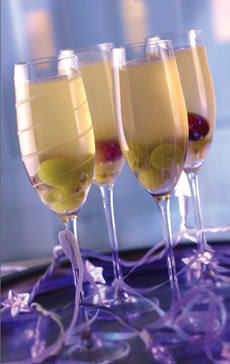 All that sparkles is not Champagne. Above, a cocktail with Prosecco, an Italian sparkling wine. Get the recipe. Photo courtesy Harvard Common Press. All that sparkles is not Champagne. Above, a cocktail with Prosecco, an Italian sparkling wine. Get the recipe. Photo courtesy Harvard Common Press.
|
R. VERONIQUE FITZGERALD is wine consultant and writer in New York City.
|
December 2007
Updated December 2008
|
 |
Product Reviews / Main Nibbles / Wine
Champagne & Sparkling Wine
Page 5: Other “Traditional Method” Sparkling Wines
This is Page 5 of a five-page article. Click on the black links below to visit other pages.
Other “Traditional Method” Sparkling Wines
Gratien & Meyer Saumur Blanc Brut NV
$15.00
From Alfred Gratien’s Loire Valley winery comes a selection of sparklers, properly classified as Crement de Loire. The Saumur Blanc Brut NV, made from Chenin Blanc, is mineral and earthy, not as silky as the Champagne, but well balanced and intriguing nonetheless.
Penley Estate Coonawarra Traditional Method 2001
$25.00 to $33.00
Here’s a great traditional method rosé sparkler from Australia’s Limestone Coast Zone, a blend of 85% Pinot Noir and 15% Chardonnay. Salmon colored with ripe strawberries on the nose and a light, fruity profile, this bubbly is beautifully balanced and very tasty. It provided a great contrast to the pepperoni pizza I was dining on the evening I tasted it: It cleaned the palate after every rich, salty bite with fresh fruit and crisp acidity. Beware of older vintages; the 2001 seemed to be drinking at its peak this year, a 1997 might be in good condition if it were carefully stored.
Prosecco
Prosecco is made by the Tank Method, also known as the Charmat process (named for its inventor), bulk method, cuve close (French for sealed tank), granvas (Spanish) or autoclave (Italian). The second fermentation happens in a stainless steel tank and the result is bottled under pressure. This is a much less expensive way to do the job, and wines made by this method are less expensive than traditional method bubblies. The bubbles tend to be less integrated, larger and coarser, and they usually dissipate faster.
One of the most fun tank method bubblies to drink is Prosecco. Hailing from northeast Italy’s Veneto region just west of the township of Conegliano, Prosecco is also the name of the grape variety from which the wine is made. It is often labeled Prosecco di Conegliano Valdobbiadene, after its appellation. The wine can be frizzante (just slightly fizzy, sometimes bottled with a regular cork to be opened with a corkscrew) or spumante (very fizzy, bottled with the mushroom-style cork and cage or something similar), like Moscato di Asti and Asti, respectively.
Fantinel Prosecco Extra Dry NV
$10.00 to $15.00
This Prosecco is fresh and crisp, with a typical lavender-laced aroma and just a spot of sweet blueberry and blackberry fruit. It’s widely available at around $10.00 a bottle. Other great Prosecco brands include Carpene Malvolti, Zardetto, Riondo, Mionetto and Bartenura (which is kosher—the company also makes kosher Asti).
Many of these Prosecco houses also make pink bubblies that cannot be labeled Prosecco. Prosecco is a white grape; the pink bottlings are often made from Pinot Noir. The rosés tend to be as much as $5.00 more per bottle, still cheaper than rosé Champagne by far.
If it’s red bubbly you want for Christmas, see my June 2007 article, Summer Red Wines to learn about Brachetto d’Acqui. Also, try a sparkling Shiraz from Paringa or Fox Creek. While these are normally dry, they usually have that jammy Shiraz fruit that makes them nice to drink. Expect to spend $13.00 to $18.00 a bottle on sparkling Shiraz.
Enjoy these bubblies at your holiday parties and dinners and to toast the New Year!
Go To The Article Index Above
Lifestyle Direct, Inc. All rights reserved. Images are the copyright of their respective owners.

|




